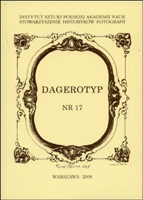Polscy fotografowie w Paryżu w drugiej połowie XIX wieku – zarys problematyki
Polish photographers in the second half of 19th century in Paris - outline of the problem
Author(s): Małgorzata Maria GrąbczewskaSubject(s): Photography
Published by: Instytut Sztuki Polskiej Akademii Nauk
Keywords: photography; Polish photography; vintage photography; history of photography; old photographic technique; Paris; commercial photography; Polish emigracy; Ken; Aleksander
Summary/Abstract: The activity of Polish photographers abroad is an almost completely unknown area of research. The work of Polish photographers based in Paris during the second half of 19th century is of considerable significance to the history of photography and requires further investigation. The author of this article is aware of the fact that the subject undertaken is complex demanding extensive research. This article is intended to provide an introduction to the problem while seeking to present its diversity. Polish photographers working in Paris can be divided into several groups. The first of these involves brief sojourns in the French capital (e.g. Karol Beyer), with the intention of educating themselves in the art of photography, to present their work at exhibitions as well as to acquaint themselves with other photographers and/or the suppliers of photographic equipment and materials. The author is not interested in this group; nor is she writing about photographers (whether Polish or French) who worked in someone else’s studio. The second category is composed of emigrants who had already become photographers before leaving Poland and decided to continue their work in Paris, or alternatively did not become professionally engaged until already living away from their homeland. The third group is formed by emigrants, but of different professions who took up photography after retiring. There is also a group of artists (mainly painters), who operated an studio as a source of income, or as an attempt to realise previously unfulfilled artistic ambitions (e.g. Antoni Pietkiewicz, Władysław Ciesielski). The fourth and final category consists of amateurs of aristocratic backgrounds or belonging to the Polish intelligentsia, for whom photography represented a form of entertainment, only due to financial backing and extended contacts they proved able to achieved a high technological and artistic level (e.g. Władysław Ksawery Chodźkiewicz). In her research the author devoted her attention to photographs with the names and studios. addresses written on the post-cards. She investigated emigration press and various archives. All in all, she succeeded in gathering information on a litttle under 40 photographers (cf: the list published in the appendix 1). She also discovered the names of those who patented new technological inventions and improvements in their photography (see the appendix 2). Among many photographers listed in the article, special attention is drawn to Aleksander Ken, who, apart from possessing his own studio (from 1878) and making the invention of a diaphragm system had written, in 1864, the book Dissertations historiques, artistiques et scientifiques sur la photographie. The Polish translation of the introduction to this book is adjoined in appendix 3.
Journal: Dagerotyp
- Issue Year: 2008
- Issue No: 17
- Page Range: 7-29
- Page Count: 24
- Language: Polish
- Content File-PDF

